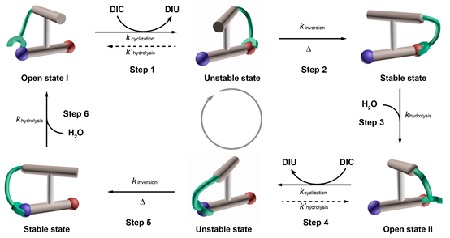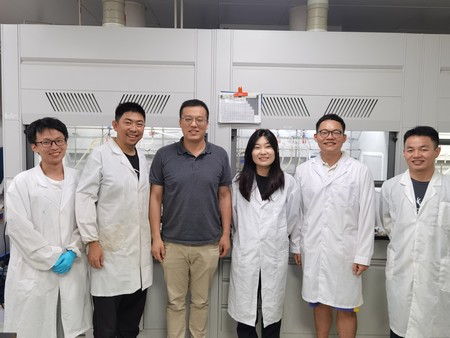Nieuwe moleculaire motor loopt op chemische brandstof
Een team onder leiding van Ben Feringa, hoogleraar Organische Chemie aan de RUG, en Depeng Zhao van Sun-Yat Sen University in Guangzhou, China, heeft een moleculaire motor ontwikkeld die één kant op draait en net als motorcomplexen in onze cellen loopt op chemische brandstof. Eén omwenteling van de motor verloopt in zes stappen. De nieuwe moleculaire motor, die op 6 juli in het wetenschappelijke tijdschrift Nature beschreven is, zou op den duur bruikbaar kunnen zijn om mechanisch werk te verzetten.

Chiraliteit
Een draaiende kunstmatige moleculaire motor is voor het eerst beschreven in 1999, door Feringa. Het leverde hem een aandeel op in de Nobelprijs voor Chemie van 2016. Zijn moleculaire motoren draaien voornamelijk op licht. Maar motormoleculen in de natuur, zoals de krachtbron die de zweepstaart van bacteriën doet ronddraaien, of het ATP synthase complex aandrijft, gebruikt chemische energie. Tot nu toe zijn er nog geen kunstmatige, in één richting draaiende moleculaire motoren die werken zonder toevallige (Brownse) beweging gemaakt die werken op deze energie.
Feringa was een van de twee leiders van een team wetenschappers dat werkte aan de bouw van juist zo’n motormolecuul in het Guangdong Provincial Key Laboratory of Chiral Molecule and Drug Discovery aan de Chinese Sun Yat-Sen University. Hun doel was om een molecuul te bouwen dat zelfstandig kon werken en in één richting zou draaien. Het resultaat kreeg de naam Motor-3 en bestaat uit twee delen, een stator en een rotor. Die laatste bevat twee chirale centra, moleculaire structuren die in twee spiegelbeeldversies bestaan, zoals een linker- en rechterhand. Chiraliteit is een van de sleutels om een beweging in één richting te krijgen

Toepassingen
De twee delen van het motormolecuul zijn verbonden met een ‘as’ die gevormd is door een dubbele binding tussen twee koolstofatomen. De energie voor de rotatie komt van een cabodiimide molecuul. Motor-3 kan daar energie aan onttrekken door het om te zetten in ureum. Op die manier kan het motormolecuul tot 98 procent van de brandstof verbruiken, om de eerste stap van de rotatie te zetten. De rotatie is bovendien voor 99 procent in één richting. De snelheid waarmee de motor draait is nog lang niet zo groot als van licht aangedreven moleculaire motoren, waarbij een rotatie slechts enkele nanoseconden duurt. Maar het team heeft er vertrouwen in dat door een verbeterd ontwerp een latere generatie van Motor-3 net zulke snelheden kan behalen.
Motor-3 kan nu op twee manieren draaien: synchrone beweging door pulsen van chemische brandstof bij een oscillerende zuur-base wisseling, of een autonome beweging onder licht basische condities. Een motor die op chemische energie loopt zou allerlei toepassingen mogelijk maken, naar het voorbeeld van de moleculaire motoren die actief zijn in levende organismen.
Referentie: Ke Mo, Yu Zhang, Zheng Dong, Yuhang Yang, Xiaoqiang Ma, Ben L. Feringa & Depeng Zhao: Intrinsically unidirectional chemically fuelled rotary molecular motors. Nature, 6 July 2022

Meer nieuws
-
05 november 2025
Tien jaar tegels wippen
-
04 november 2025
Protheses waarbij de mens centraal staat

